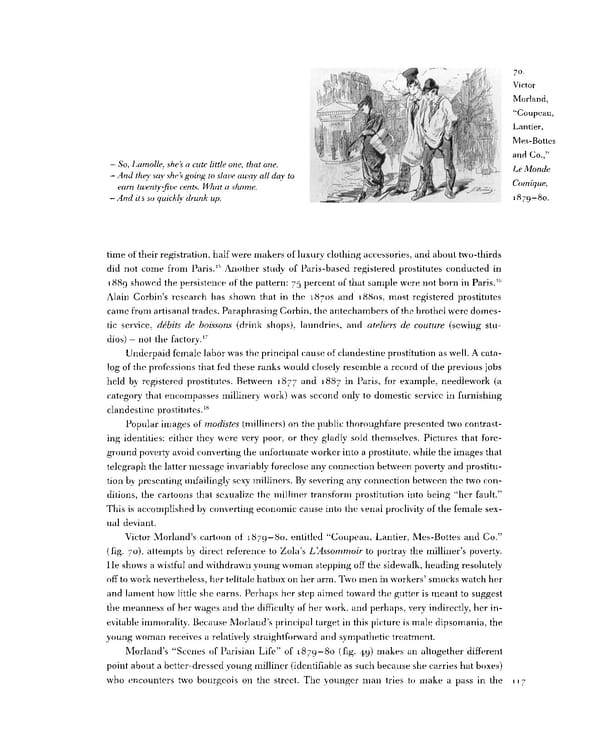70. Victor Morland, "Coupeau, L an tier, Mes-Bottes and Co.," - So, Lamolle, she's a cute little one, that one. Le Monde - And they say she's going to slave away all day to earn twenty-five cents. What a shame. Comique, — And its so quickly drunk up. 1879-80. time of their registration, half were makers of luxury clothing accessories, and about two-thirds 15 did not come from Paris. Another study of Paris-based registered prostitutes conducted in 16 1889 showed the persistence of the pattern: 75 percent of that sample were not born in Paris. Alain Corbin's research has shown that in the 18708 and i88os, most registered prostitutes came from artisanal trades. Paraphrasing Corbin, the antechambers of the brothel were domes- tic service, debits de boissons (drink shops), laundries, and ateliers de couture (sewing stu- dios) — not the factory.17 Underpaid female labor was the principal cause of clandestine prostitution as well. A cata- log of the professions that fed these ranks would closely resemble a record of the previous jobs an held by registered prostitutes. Between 1877 d 1887 in Paris, for example, needlework (a category that encompasses millinery work) was second only to domestic service in furnishing clandestine prostitutes.18 Popular images of modistes (milliners) on the public thoroughfare presented two contrast- ing identities: either they were very poor, or they gladly sold themselves. Pictures that fore- ground poverty avoid converting the unfortunate worker into a prostitute, while the images that telegraph the latter message invariably foreclose any connection between poverty and prostitu- tion by presenting unfailingly sexy milliners. By severing any connection between the two con- ditions, the cartoons that sexualize the milliner transform prostitution into being uher fault." This is accomplished by converting economic cause into the venal proclivity of the female sex- ual deviant. Victor Morland's cartoon of 1879 — 80, entitled "Coupeau, Lantier, Mes-Bottes and Co." (fig. 70), attempts by direct reference to Zola's UAssommoir to portray the milliner's poverty. He shows a wistful and withdrawn young woman stepping off the sidewalk, heading resolutely off to work nevertheless, her telltale hatbox on her arm. Two men in workers' smocks watch her and lament how little she earns. Perhaps her step aimed toward the gutter is meant to suggest the meanness of her wages and the difficulty of her work, and perhaps, very indirectly, her in- evitable immorality. Because Morland's principal target in this picture is male dipsomania, the young woman receives a relatively straightforward and sympathetic treatment. Morland's "Scenes of Parisian Life" of 1879 — 80 (fig. 49) makes an altogether different point about a better-dressed young milliner (identifiable as such because she carries hat boxes) who encounters two bourgeois on the street. The younger man tries to make a pass in the 117
 Prostitution & Impressionists Page 137 Page 139
Prostitution & Impressionists Page 137 Page 139